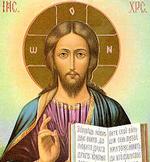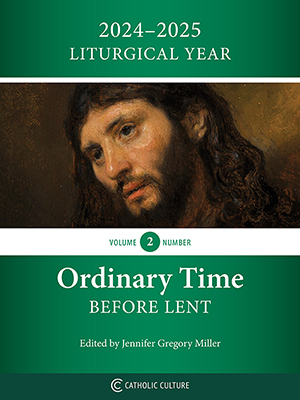Catholic World News News Feature
The Birth of Liturgical Reform January 09, 2002
Interview by Robert Hutchinson
Abbot Boniface is one of the very few living witnesses to the entire decade's long effort to reform and revitalize the Roman Catholic liturgy. Born in Belgium at the start of World War I, Abbot Boniface was ordained in 1940., and earned his doctorate in theology at the University of Louvain. After World War II he became involved in the burgeoning liturgical movement.
In 1959, largely because of his reputation as a liturgical scholar, Abbot Boniface was appointed as a consulter to the preparatory commission for liturgy for Vatican II. His primary task involving working with Sacrosanctum concilium, the Constitution on the Sacred Liturgy, of which he wrote several sections. During the Council from 1962 to 1965 he served as a peritus or theological expert. Finally Abbot Boniface was appointed a member of both the concilium and the Sacred Congregation for Divine Worship. (The Concilium, headed by Archbishop Anniballe Bugnini, was given the task of implementing the liturgical reforms of Vatican II. ) He is the author of the forthcoming book, Vatican II Revisited.
[TEXT]
Could you tell us a little bit about the origins of the liturgical movement and your personal involvement with it.
Abbot Boniface: The liturgical movement--in Europe, let us say, because it is there that it started--goes back very long ago. So, for instance during the first World War it had begun already. But then the real date that you can pinpoint is at the beginning is 1919 with Don Lambert Bourdoin, the founder of a Byzantine bi-ritual monastery in Southern Belgium. He was a very dynamic man.
The liturgical movement published all kinds of missals and pamphlets in order to bring the liturgy into the schools and into the homes. This was important, so that it became a movement of life, and especially a youth movement. That's why I also was very active in the youth movement; because both went together.
It was the work of a whole group of enthusiastic people. One of the characteristics of the liturgical movement was that all these people were friends. They knew each other; they met each other readily all over the world--in Assisi, in Munich, in Colognein Belgium, in Holland. And they had great leaders. That was its power.
On the other hand, it was very submissive to the magisterium. There was no revolutionary mentality in it at all. For instance, I think you asked about the Tridentine Mass. Well, everybody knew that it was not sufficient any more. (I will come back to that point later.) But they did not stop celebrating it. They tried to make out of it what they could.
I am still unclear as to what the actual goals of the Liturgical Movement were. Was it merely to educate the people regarding the current liturgy, as it was structured at the time? Or was it to actually to change the liturgy and change some of the the rites? It seems to me these are two different things.
Boniface: Yes. But, here again the difference between before the Council and after the Council, is this: Everybody was willing to use the liturgy as it was; but they came more and more to the conclusion that it did not work.
Our main idea was this: that the vernacular is necessary; that is a principle inherent in the liturgy. That is why the Eastern liturgies, which are faithful to the primitive Christian set-up, all have the vernacular. And that was why the Mass was in Latin--because it was a vernacular.
After the Council, I would say, the unspoken basic principle was to align the Church totally with modern civilization--and therefore with street language, and with ICEL. That language is not the sacred language of the liturgy, but the language of a handful of specialists who were almost possessed with the principle of acculturation. That was not done by the Council.
You once wrote of the pre-conciliar Latin Mass that although perhaps it was excellent in itself, nevertheless the manner in which it was celebrated could not continue.
Boniface: That's another point. The liturgy was not a part of the life of the clergy and of the people. The priests rambled off without contact with the people. The laity could never receive Holy Communion from hosts consecrated at the same Mass. On Sunday they consecrated a big ciborium of hosts for the whole week. St. Thomas speaks of that in his Summa Theologica; he says, "It is stupidity to receive Holy Communion from gifts that are consecrated in a previous Mass."And that is what happened all the time. So that could not go on.
What about some of the later proposals such as the turning of the priest around., and the altar being pulled back so you could walk around it. Was that part of the liturgical movement, or did that come after?
Boniface: That was one of the propositions, but optional. My good friend Father Josef Jungmann worked so that the priest could use the altar at both sides, as it was in the early Church. Where the priest is the president, for instance in the service of the Word, he has to lead the congregation and encourage the congregation. But then during the Canon, he is the prayer par excellence, the leader of the prayer of the community; there he should be the leader; that means with the back to the people.
But then at the end of his life, Jungmann pleaded for not accepting the altar facing the people, because it was the cause of so many abuses that he said, "this cannot be the will of God." So he was against it.
This issue of the altar seems to be a matter of some dispute. Advocates for having the priest turn around and face the people insisted this was the practice of the early Christians by and large...
Boniface: No, no that is not true. There are many are many things that are not right. That was true in the four Roman basilicas, but not in the other Churches. So for instance in San Clemente or in Santa Sabina, the priest was turned with his back to the people.
What about this notion of the priest as presider, or president of the assembly. In English the presider is merely someone who steps up to take the podium. This seems to undermine the notion that the priest has a unique role in persona Christi.
Absolutely. The priest is the president and the leader of the whole congregation. Therefore he stands with his back to the people, because the people push him forward before the face of God.
You have spoken of the liturgical movement as going back to the sources of Christian life.
Boniface: Yes, that was the difference between before and after, once again. After the Council they did not recognize any tradition or any power, any authority, in the continuity in the Church. But before the Council the renewal existed according to the proposal of returning to the sources.
By and large the Council did not do that. They jumped over the sources. They went to the primitive sources of the 2nd and 3rd centuries. But you see, they celebrated in the catacombs, for a small group, and they faced the wall and so on. The real reform of the western liturgy had been made in the 8th and 9th centuries. So we missed the boat.
So you say they went back too far? They didn't take account of the development of the liturgy and the subsequent centuries?
Boniface: Right. The reason was that they really did not accept any tradition, any development.
You also spoke of eliminating what you said, were suffocating acretions, and rejuvenating the Church that way. What was it that was so suffocating about the old rite?
Boniface: You have no idea, because you celebrate in the vernacular. But everything was rattled off in an un-understandable Latin; even for us who knew Latin could not understand. It was mumbled far away at the altar, without any concern for active participation.
If the laity was so disengaged from the old Latin Mass, why was Mass attendance 70 percent or better in the United States? And now, the Mass attendance is 25 percent.
Boniface: For many reasons, many reasons. First, our the society has been thrown open. Each one stands for his own responsibility and has to go to Church when he decides to go. That did not exist at that time; everybody went to Church. Secondly, the liturgy has been totally horizontalized, and people are not interested in that; they want to come to church to pray.
Traditionalists will grant that perhaps the people were not actively involved in the liturgy as much as the liturgical movement wanted. But the people in the past did come to church and they did pray. Nowadays they come to church and perhaps they don't pray.
Boniface: They did not pray. Some people prayed the Rosary; that is true. Or there were prayer books. But they did not celebrate the Mass.
Mediator Dei , the encyclical of Pope Pius XII, extinguishes two elements of active participation: interior participation and exterior participation, or expressed participation. One cannot exist without the other. When you play out the interior participation against active participation outside, that is not right. Both need each other. That is what the liturgical movement wanted. There was very much interior participation, but not active participation.
[AUTHOR ID- EQUIVALENT] This interview is taken from the transcript of a much longer question-and-answer session. The full interview, on three cassette tapes, can be obtained from St. Joseph Comunications, PO Box 720, W. Covina, California 91793.






